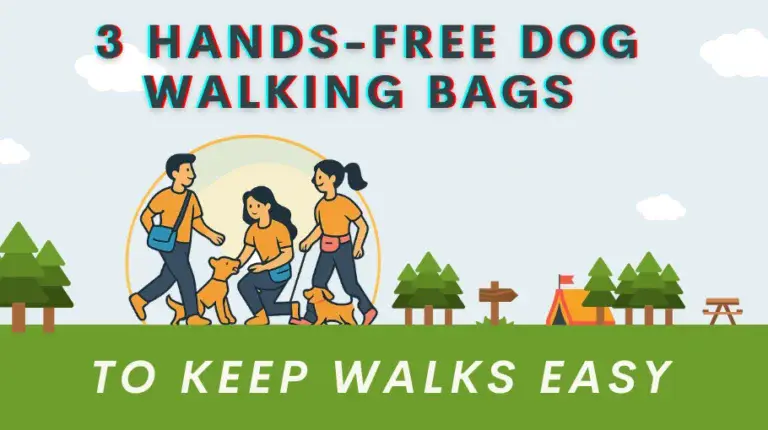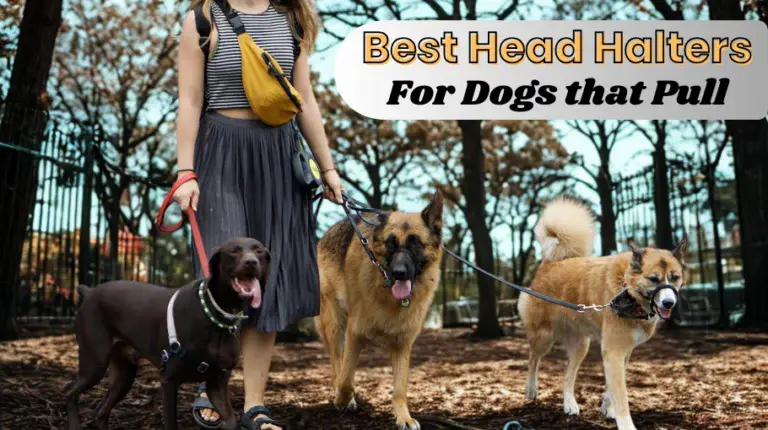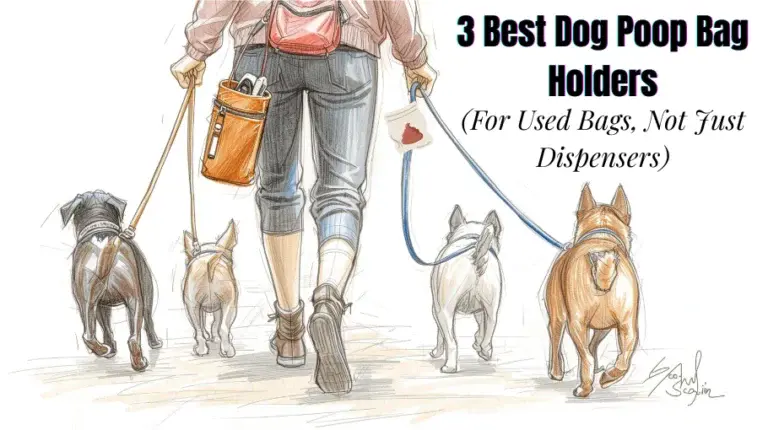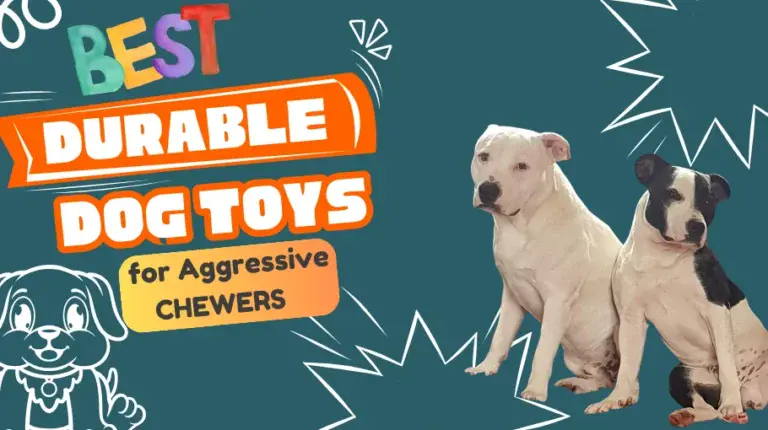The 3 Best Dog Harnesses for Strong Pullers
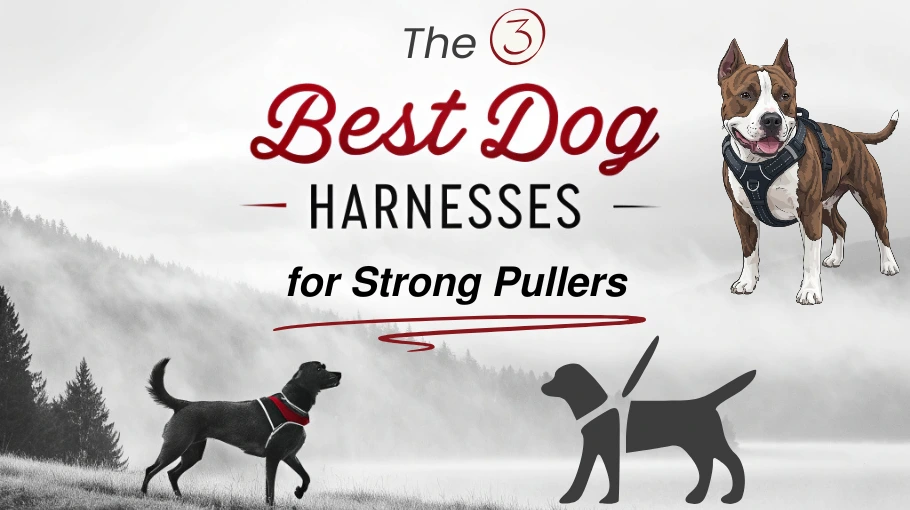
In our house, harnesses are preferred to collars — we’ve got two Staffies, and they rough house a lot. Not even the best dog harnesses are without flaws, but it beats replacing shredded collars every month.
With harnesses, I’ve found two features that matter most:
- a front clip (for managing pulling), and
- a handle (for quick control or lifting).
That said, there isn’t a one-size-fits-all “best” harness. What works for me might not suit you, and different harness types shine in different situations. So, I’ve split my top three picks into categories — no-pull, handle, and padded — so you can match the style to your dog’s needs.
3 of the Best Dog Harnesses for Strong Pullers
➔ Best No-Pull Dog Harness: Blue-9 Balance

- ✅ Six adjustment points for a snug fit (good for escape-artist dogs).
- ✅ Minimal bulk — light and unobtrusive.
- ✅ Dual attachment points (front and back).
Best for:
Owners who want adjustability and a front-clip setup to make walks more manageable.
Pros:
- Six adjustment points for a snug fit (good for escape-artist dogs).
- Minimal bulk — light and unobtrusive.
- Dual attachment points (front and back).
Cons:
- No padding — can rub if fit isn’t perfect.
- Can twist or slide if the dog pulls hard.
- Not a “miracle cure” — still requires training.
My Take:
No-pull harnesses don’t stop pulling; they just make it less pleasant for the dog to lean in and drag you. With the Blue-9, you clip the lead to the front ring, and that redirect makes walking easier on your shoulders.
For my two Staffies, I actually got better results using the EzyDog Convert harness with the Vario 6 lead in front-clip mode — that combo was the first time my other half could handle the dogs. But as a lean, versatile harness, the Blue-9 is a solid option as it features a similar setup.
What Makes It Stand Out:
The adjustability. If your dog is hard to fit or tends to slip out of other harnesses, the Balance can usually be dialed in securely.
Check the latest deals on the Blue-9 Balance Dog Harness here.
➔ Best Dog Harness with a Handle: EzyDog Convert

- ✅ Built-in sturdy handle for instant control
- ✅ Sturdy construction with back and optional front clip.
- ✅ Works well with the EzyDog Vario 6 adjustable dog lead.
Best for:
Dogs that need quick handling in busy places, or owners who want a convertible harness for everyday use.
Pros:
- Built-in handle for instant control.
- Sturdy construction with back and optional front clip.
- Works well with the EzyDog Vario 6 adjustable dog lead.
Cons:
- Less padding than premium padded harnesses.
- Lifting can dig straps into the chest if not careful.
- A bit bulkier than strap-only styles.
My Take:
I use the handle most when my bigger Staffy gets over-excited around people or other dogs. One grab and I’ve got him back under control. It’s also handy for helping him into the boot (he’s not a strong jumper), though I’ve learned to be careful — the straps aren’t as padded as something like the Ruffwear, so lifting can pinch. As a hybrid harness with a handle and a front-clip option, it’s one of the most versatile picks.
What Makes It Stand Out:
The sturdy handle. For reactive or excitable dogs, having that instant “grab point” can save a situation fast.
Besides that, the front padded strap is both strong and padded for comfort, and with EzyDog’s purpose-designed front-clip D-ring attachment (a secure Velcro add-on), you can turn the Convert into a true no-pull harness.
The side panels are customisable too — the branded logo strips are removable and replaceable with Velcro patches. The company used to offer generic replacements like “Bodyguard” or “Security,” and now you’ll find independent sellers on Etsy who can make custom name tags if you want something more personal.
And if you’re into hiking, EzyDog even sell a Summit Backpack that fastens directly to the Convert (hence the name). Personally, I’ve held off on that one — with two Staffies who love to barrel-roll in the grass, I think it’d get destroyed on day one. But for calmer dogs on longer walks, it’s a handy add-on.
Get the latest offers on the EzyDog Convert Harness here
➔ Best Padded Dog Harness: Ruffwear Web Master

- ✅ Heavily padded and comfortable.
- ✅ Strong, durable build for big or strong dogs.
- ✅ Handle well-positioned for lifting safely.
Best for:
Dogs who need regular lifting support (seniors, mobility issues) or outdoor adventures.
Pros:
- Heavily padded and comfortable.
- Strong, durable build for big or strong dogs.
- Handle well-positioned for lifting safely.
Cons:
- Bulkier than everyday harnesses.
- Higher price point.
- Can get warm in hot weather.
My Take:
One of my Staffies isn’t a strong jumper so he needs the occassional lift, like getting into the car, and the handle on the Ruffwear would likely make that lift a lot more comfortable — both for him and for me. I’d also recommend it for cross-country walks where you need to help your dog over obstacles like stiles (the step things for walkers to get over fences). If you’re after comfort and support for your dog, this is the harness I’d trust most.
What Makes It Stand Out:
Comfort. The padding distributes pressure evenly, making it the go-to choice for dogs who need more regular handling or support.
Check the latest deals on the Ruffwear Web Master here.
Choosing a Harness: Lessons from Years of Experience
Owning two Staffies has meant experimenting with many harnesses, from puppyhood to adulthood. Here’s what I’ve learned about choosing the right harness for strong pullers.
No-Pull vs. Front, Back, or Dual-Clip Harnesses
In my experience, “no-pull” harnesses are essentially front-clip designs. Dual-clip setups may seem ideal, but the back clip can actually encourage pulling, while the front clip discourages it. The result has been confused dogs walking sideways. I’ve had better results using only the front clip, combined with consistent reinforcement of commands like “heel” or “easy.”
Head Halters as Backup
For stubborn pullers, a head halter can be used alongside a harness rather than just a collar. This gives better control and helps prevent the dog from dragging sideways when they insist on pulling.
Handles for Quick Control
Handles aren’t just for lifting — they can be a lifesaver if your dog lunges or becomes reactive. When choosing a harness with a handle, look for reinforced stitching: double-stitched straps with strong thread will stand up to real-world use better than a simple single-stitched strap.
Fit and Comfort Considerations
- Measure carefully: Chest, stomach, and neck size are critical; a poor fit is the #1 reason dogs slip out.
- Adjustability: Check straps regularly — especially on strong pullers — to prevent loosening or chafing.
- Padding: Strong pullers benefit from padded straps that distribute pressure evenly and protect both the dog and the handler.
- Freedom of movement: The harness should not restrict natural gait; tight or poorly fitted straps can lead to orthopedic problems over time.
Conclusion
There’s no single “best” dog harness for strong pullers — only the best type for your situation. If you want control, start with a front-clip no-pull harness like the Blue-9 Balance. If you need quick handling, the EzyDog Convert is a versatile pick. And if comfort and lifting are priorities, the Ruffwear Web Master is worth the investment.
Harnesses make walks more manageable, but remember: they’re tools, not miracle fixes. Pair them with consistent training, and your shoulders (and your dog) will thank you.
Check out the latest deals using the links below:
FAQs
Are dog harnesses better than collars?
Harnesses can be better than collars for many dogs, especially strong pullers or breeds prone to trachea injury. They distribute pressure more evenly across the chest and shoulders, reduce the risk of choking, and offer better control during walks. That said, a well-fitted collar is still useful for ID tags and short, controlled outings.
Do no-pull dog harnesses stop pulling?
Not entirely. No-pull harnesses make pulling less rewarding, usually via a front-clip design that redirects your dog’s momentum. Strong or stubborn dogs may still pull, so pairing the harness with training or a head halter is often the most effective approach.
Are dog harnesses machine washable?
Many dog harnesses are machine washable, but it depends on the material and manufacturer instructions. Padded or heavy-duty harnesses often benefit from hand washing to protect straps, padding, and stitching. If using a washing machine, place the harness in a mesh laundry bag and use the lowest spin speed to prevent metal clips from hitting the drum.
Are all dog harnesses safe for car journeys?
Dog harnesses are generally safer than collars in vehicles, reducing the risk of neck injuries during sudden stops or accidents — especially when attached via the back clip. However, not all harnesses are designed for crash safety. For long trips or maximum protection, consider a crash-tested, car-safety rated harness appropriate for your dog’s weight.
How do I choose the right size of harness for my dog?
Measure your dog’s chest, neck, and girth carefully and compare the measurements to the manufacturer’s sizing chart. A harness should fit snugly but allow two fingers to slide comfortably between the strap and your dog’s body. Adjustable straps can help fine-tune the fit, but avoid sizes that are too loose or too tight.
Can dogs escape from harnesses?
Yes, some dogs are escape artists, especially if the harness is poorly fitted or designed without multiple adjustment points. Front-clip harnesses with multiple adjustment straps tend to be more secure. Always supervise your dog during walks and ensure the harness is properly fastened before heading out.
What type of harness is best for reactive or strong dogs?
Front-clip or no-pull harnesses are generally best for strong or reactive dogs, as they redirect pulling and give the handler better control. For dogs that are extremely strong or reactive, a front-clip harness combined with a head halter can provide additional steering control without restricting movement.

